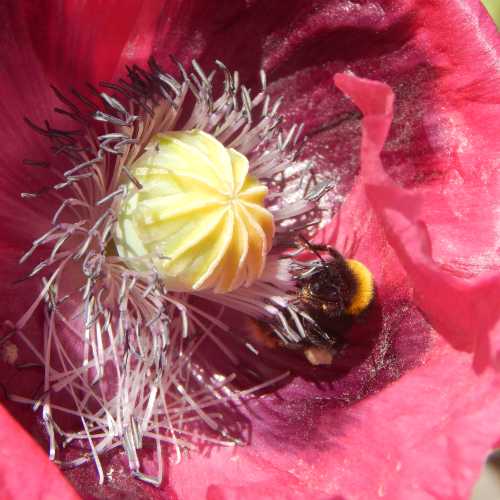Which Wildflowers Provide The Most Nectar And Pollen For Bees?
In 2016, Hicks et al1 published a paper, in which the average nectar and pollen reward of a number of wildflowers was compiled and presented in tables - along with other data recording and measuring a variety of factors.
Below, I have taken parts of the data and present it here to provide an overview of the average (mean) nectar and pollen reward recorded for each flower, as well as the average floral longevity (in days).
Why might this data be useful?
If you are considering adding wildflowers to your flower border, you might be looking for information on which to include, based on a desire to provide the maximum amount of food for bees in the form of nectar and pollen. Both nectar and pollen are important for feeding individual bees and for rearing larvae.
However, it's worth noting there are limitations to the data - for example, a number of beautiful and very beneficial wildflowers are not included, and I elaborate on a number of considerations below.
Selecting Wildflowers For Nectar And Pollen
It's no secret that bees need nectar for energy which they get from the carbohydrate sugars, and pollen for lipids, protein and for maintaining good health.
Some flowers offer an abundance of both for bees to feed on, whilst others provide only one, but in abundance. Of course, some flowers offer little of value to bees.
Additionally, there are pollinator species which have a preference for only one or two plants (pollinator constancy), and seasonality factors are also relevant, as well as local environment.
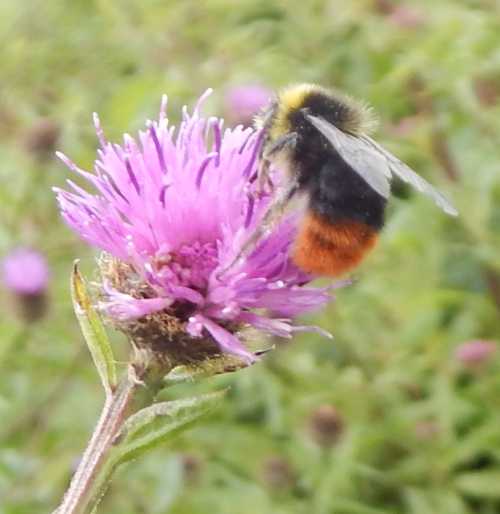
Which wildflowers should I include in my garden?
5 recommended wildflowers
If you have limited space, then based on the lists below, and my own personal experience, my top 5 recommended wildflowers from those listed in the tables are:
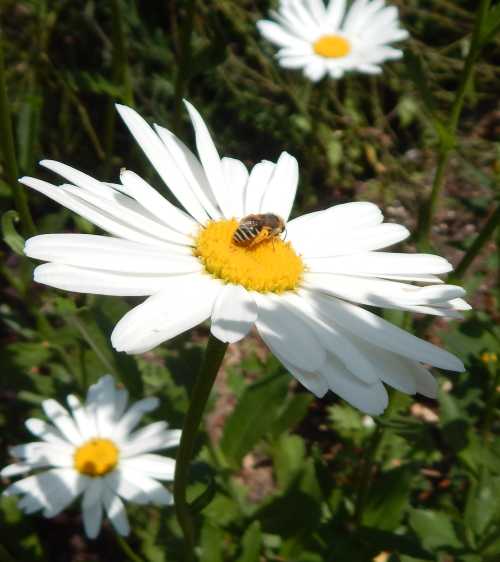
Oxeye daisy - Leucanthemum vulgare
Flowers remain for several days to provide bees and other pollinators with an extended opportunity to feed on the cheery blooms. Offers lots of pollen and good amounts of nectar.
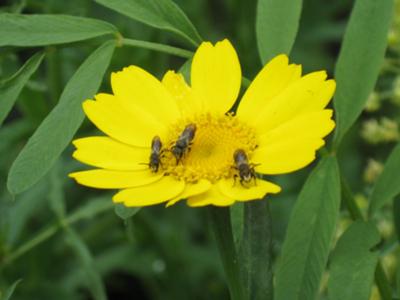
Corn marigold - Glebionis segetum
Easy to grow, and great in the border as a cheery plant, with a shorter, more compact growing habit that oxeye daisies.
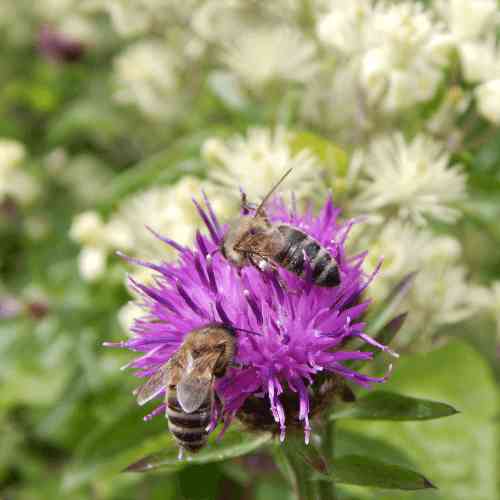
Common knapweed - Centaurea nigra
If you have an abundance of this flower in your immediate surroundings, then perhaps it's not one you need to include in your garden. Otherwise, it's a fantastic all-rounder for bees and a myriad other pollinators.
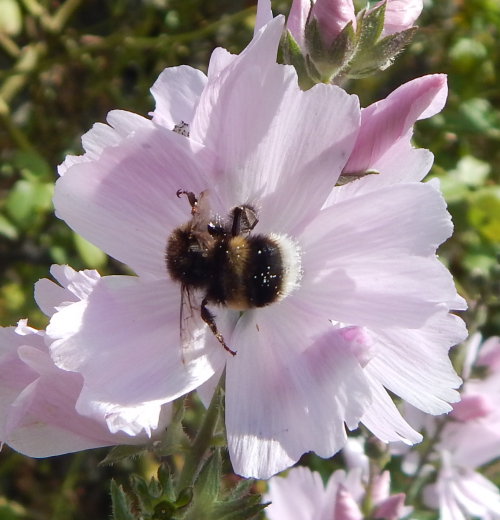
Musk mallow - Malva moschata - also known as Provides ample pollen for bees, and is attractive to a range of bee species. Please note, the image left is another member of the mallows (Malvaceae family) a Prairie mallow, another stunning flower available for gardens.
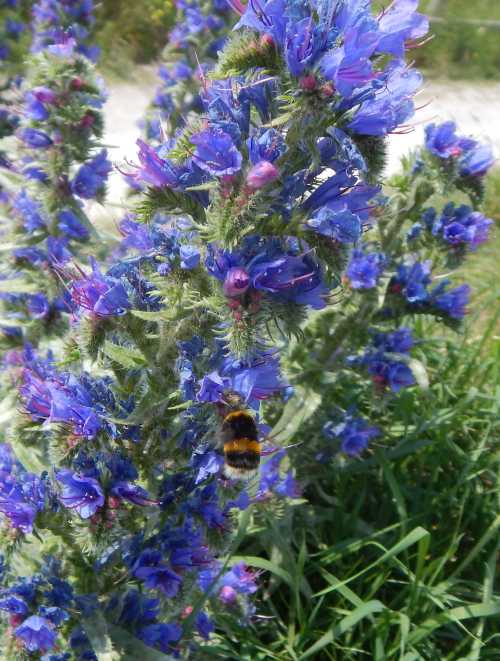
Viper's bugloss - Echium vulgare
A superb plant, again offering nectar and pollen, and attractive to a range of bee species.
Below are the tables outlining the data in µg (micrograms).
I provide my reasons for recommending certain wildflowers and not others, below the tables.
Wildflower pollen reward
| Common name | Scientific name | Mean volume of pollen per flower per day (µl/day) | Floral unit longevity (days) |
|---|---|---|---|
| Musk Mallow | Malva moschata | 2.274 | 2.232 |
| Common Knapweed | Centaurea nigra | 2.058 | 3.112 |
| Dandelions | Taraxacum agg. | 1.255 | 2.250 |
| Ox-eye Daisy | Leucanthemum vulgare | 1.077 | 14.783 |
| Rosebay Willowherb | Chamerion angustifolium | 0.689 | 4.200 |
| Corn-marigold | Glebionis segetum | 0.609 | 8.333 |
| Cat's-ear | Hypochaeris radicata | 0.365 | 3.526 |
| Scentless Mayweed | Tripleurospermum inodorum | 0.348 | 8.500 |
| Autumn Hawkbit | Scorzoneroides autumnalis | 0.274 | 6.684 |
| Meadow Buttercup | Ranunculus acris | 0.262 | 5.345 |
| Yarrow | Achillea millefolium | 0.247 | 4.565 |
| Rough Hawkbit | Leontodon hispidus | 0.157 | 6.684 |
| Smooth Hawksbeard | Crepis capillaris | 0.145 | 5.056 |
| Daisy | Bellis perennis | 0.145 | 4.500 |
| Pineappleweed | Matricaria discoidea | 0.134 | 3.216 |
| Prickly Sow-thistle | Sonchus asper | 0.120 | 7.824 |
| Red Campion | Silene dioica/latifolia | 0.115 | 3.128 |
| Smooth Sow-thistle | Sonchus oleraceus | 0.112 | 11.857 |
| Nipplewort | Lapsana communis | 0.107 | 3.087 |
| Creeping Thistle | Cirsium arvense | 0.104 | 5.769 |
| Common Ragwort | Senecio jacobaea | 0.099 | 9.530 |
| Creeping Buttercup | Ranunculus repens | 0.088 | 4.820 |
| Viper’s Bugloss | Echium vulgare | 0.064 | 2.360 |
| Wild Mignonette | Reseda lutea | 0.043 | 4.519 |
| Bird`s-foot-trefoil | Lotus corniculatus | 0.036 | 4.050 |
| Common Mouse-ear | Cerastium fontanum | 0.035 | 1.000 |
| Dove's-foot Crane's-bill | Geranium molle | 0.033 | 1.000 |
| Common Field-speedwell | Veronica persica | 0.031 | 1.000 |
| Selfheal | Prunella vulgaris | 0.029 | 1.090 |
| Tufted Vetch | Vicia cracca | 0.028 | 1.350 |
| Common Groundsel | Senecio vulgaris | 0.028 | 6.294 |
| Broad-leaved Willowherb | Epilobium montanum | 0.026 | 2.000 |
| Red Dead-nettle | Lamium purpureum | 0.019 | 1.052 |
| Common Hemp-nettle | Galeopsis tetrahit | 0.017 | 1.912 |
| Charlock | Sinapis arvensis | 0.015 | 2.575 |
| White Clover | Trifolium repens | 0.014 | 2.058 |
| Wild Red Clover | Trifolium pratense | 0.012 | 1.675 |
| LesserStitchowort | Stellaria graminea | 0.007 | 3.065 |
| Hairy Tare | Vicia hirsuta | 0.006 | 1.000 |
| Ribwort Plantain | Plantago lanceolata | 0.005 | 2.362 |
| Common Fumitory | Fumaria officinalis | 0.005 | 2.031 |
| American Willowherb | Epilobium ciliatum | 0.003 | 3.063 |
| Common Knotgrass | Polygonum aviculare | 0.003 | 2.000 |
| Wild Marjoram | Origanum vulgare | 0.003 | 3.594 |
| Hedge Mustard | Sisymbrium officinale | 0.002 | 3.000 |
| Redshank | Persicaria maculosa | 0.002 | 1.141 |
| Wild Carrot | Daucus carota | 0.002 | 8.450 |
| Lady’s Bedstraw | Galium verum | 0.001 | 6.974 |
| Hedge Bedstraw | Galium album | 0.001 | 7.440 |
| Common Chickweed | Stellaria media | 0.001 | 2.235 |
| Field Forget-me-not | Myosotis arvensis | 0.000 | 3.635 |
Wildflower nectar reward
| Common name | Scientific name | Mean volume of nectar sugar per flower per day (µg/day) | Floral unit longevity (days) |
|---|---|---|---|
| Common Ragwort | Senecio jacobaea | 2921.434 | 9.530 |
| Creeping Thistle | Cirsium arvense | 2608.941 | 5.769 |
| Spear Thistle | Cirsium vulgare | 2322.728 | na |
| Dandelions | Taraxacum agg. | 2137.198 | 2.250 |
| Cat's-ear | Hypochaeris radicata | 1843.239 | 3.526 |
| Rough Hawkbit | Leontodon hispidus | 1826.716 | 6.684 |
| Common Knapweed | Centaurea nigra | 1473.808 | 3.112 |
| Scentless Mayweed | Tripleurospermum inodorum | 1415.790 | 8.500 |
| Corn-marigold | Glebionis segetum | 931.210 | 8.333 |
| Viper’s Bugloss | Echium vulgare | 688.269 | 2.360 |
| Prickly Sow-thistle | Sonchus asper | 593.827 | 7.824 |
| Smooth Sow-thistle | Sonchus oleraceus | 568.844 | 11.857 |
| Musk Mallow | Malva moschata | 540.649 | 2.232 |
| Autumn Hawkbit | Scorzoneroides autumnalis | 536.175 | 6.684 |
| Ox-eye Daisy | Leucanthemum vulgare | 515.213 | 14.783 |
| Wild Mignonette | Reseda lutea | 360.574 | 4.519 |
| Rosebay Willowherb | Chamerion angustifolium | 282.900 | 4.200 |
| Creeping Buttercup | Ranunculus repens | 258.854 | 4.820 |
| Selfheal | Prunella vulgaris | 246.929 | 1.090 |
| Red Campion | Silene dioica/latifolia | 144.994 | 3.128 |
| American Willowherb | Epilobium ciliatum | 144.713 | 3.063 |
| Wild Marjoram | Origanum vulgare | 144.068 | 3.594 |
| Meadow Buttercup | Ranunculus acris | 122.500 | 5.345 |
| Tufted Vetch | Vicia cracca | 110.219 | 1.350 |
| Red Dead-nettle | Lamium purpureum | 107.732 | 1.052 |
| Nipplewort | Lapsana communis | 99.347 | 3.087 |
| Bird`s-foot-trefoil | Lotus corniculatus | 59.172 | 4.050 |
| Daisy | Bellis perennis | 51.067 | 4.500 |
| Wild Red Clover | Trifolium pratense | 48.366 | 1.675 |
| Broad-leaved Willowherb | Epilobium montanum | 36.566 | 2.000 |
| LesserStitchowort | Stellaria graminea | 32.159 | 3.065 |
| Yarrow | Achillea millefolium | 31.105 | 4.565 |
| Redshank | Persicaria maculosa | 29.586 | 1.141 |
| Wild Carrot | Daucus carota | 27.177 | 8.450 |
| Hairy Tare | Vicia hirsuta | 26.763 | 1.000 |
| Common Fumitory | Fumaria officinalis | 21.898 | 2.031 |
| Field Forget-me-not | Myosotis arvensis | 21.834 | 3.635 |
| Germander Speedwell | Veronica chamaedrys | 21.383 | 2.107 |
| Dove's-foot Crane's-bill | Geranium molle | 19.273 | 1.000 |
| White Clover | Trifolium repens | 12.135 | 2.058 |
| Common Chickweed | Stellaria media | 11.918 | 2.235 |
| Common Mouse-ear | Cerastium fontanum | 11.589 | 1.000 |
| Shepherd's purse | Capsella bursa−pastoris | 9.052 | 1.465 |
| Hedge Bedstraw | Galium album | 7.056 | 7.440 |
| Charlock | Sinapis arvensis | 5.687 | 2.575 |
| Common Field-speedwell | Veronica persica | 4.686 | 1.000 |
| Hedge Mustard | Sisymbrium officinale | 3.675 | 3.000 |
| Lady’s Bedstraw | Galium verum | 3.173 | 6.974 |
| Smooth Hawksbeard | Crepis capillaris | 0.000 | 5.056 |
| Pineappleweed | Matricaria discoidea | 0.000 | 3.216 |
| Ribwort Plantain | Plantago lanceolata | 0.000 | 2.362 |
| Common Groundsel | Senecio vulgaris | 0.000 | 6.294 |
Rationale for recommendations
You may note that there are some wildflowers that score highly, which I exclude from my 'top 5' list above, such as dandelion.
My reasoning is as follows:
- The other wildflower species which score highly, are generally found in abundance in most regions, and arguably, there is no great need to cultivate them in a garden setting.
- I have selected for value to a range of bee species, and for beauty. I think most people looking to incorporate just a few wildflowers into their garden border and maximize available space, would prefer not to use flowers such as Cat's Ear (not that there's anything wrong with it), whereas the mallows offer tremendous value and are extremely pretty.
- I recommend other wildflowers for particular scenarios elsewhere on my website. For example, I have long advocated allowing clover to flourish in the lawn.
Limitations of the data as presented above
- It's important to note that the study from which I extracted the above data, provided discussion and outlined a number of variables not covered here. In other words, this article, which is already rather long, is only giving part of the story from the study.
- The study did not and could not reasonably be expected to cover every single wildflower known, and there are a number of flowers for which data is missing.
For example, Field Scabious (Knautia arvensis) is known to be very beneficial to pollinators. One study found that it provided a mean (average) nectar reward of between 2.73 and 4.33µg (micrograms) per plant species across 4 sample groups, and a range of beneficial amino acids. It received visits from bumble bees, honey bees, solitary bees and hoverflies2. - As stated previously, when planning your bee-friendly garden, it's worth taking into account flowering season, and if possible, aim to plug gaps when there might otherwise be a shortage of nectar and pollen. This element is not covered in my tables above. In addition, select a variety of flower shapes.
- Remember some pollinator species have a preference for particular types of flowers. for example, you can't go wrong with Lamb's ear to attract wool carder bees, or Pulmonaria to attract Hairy footed flower bees.
Nevertheless, the 5 species of wildflower mentioned above are all of great benefit to bees and pollinators, and certainly worthy of inclusion in the garden border.
References
1. Hicks DM, Ouvrard P, Baldock KC, et al. Food for Pollinators: Quantifying the Nectar and Pollen Resources of Urban Flower Meadows. PLoS One. 2016;11(6):e0158117. Published 2016 Jun 24. doi:10.1371/journal.pone.0158117
2. Venjakob, Christine & Leonhardt, Sara & Klein, Alexandra. (2020). Inter-Individual Nectar Chemistry Changes of Field Scabious, Knautia arvensis. Insects. 11. 75. 10.3390/insects11020075.
If you found this page helpful or interesting, I'd really be grateful if you would share it with others - if not this page, perhaps another, such as Gardening For Bees.
Thank you so much :) .
